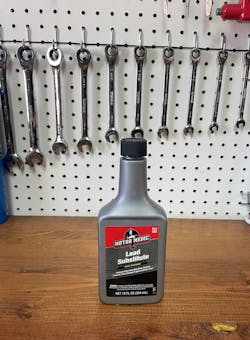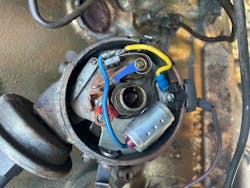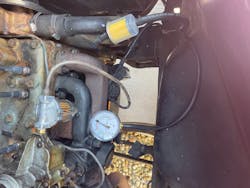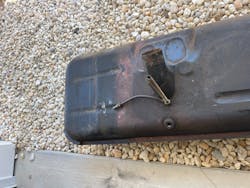Content brought to you by Motor Age. To subscribe click here.
What you will learn:
• Diagnosing "Crank/No-Starts" is as easy as focusing on what is missing from the combustion process
• Eliminating what is functioning correctly is a sound diagnostic strategy
• Getting to the root cause of a fault ensures the symptoms wont return after a repair
I've faced thousands of "crank/no-start" situations in my tenure as a mobile tech. Regardless of the many different ways engines are configured, to carry out the combustion process, three things remain consistent among all of those configurations. A gasoline internal combustion engine needs mechanical integrity, adequate fuel supply, and spark ignition to function. The process to find the fault is easy when you have a solid understanding of what it is you are working on.
A first-time encounter
I was 16 years old and the first vehicle I ever owned was a 1953 Dodge B-4-B half-ton pickup truck. It was equipped with a straight-six flat head, 218 Cubic Inch engine. Back in 1978, i purchased this vehicle from my high school mechanic teacher for a whopping $500 (which was a lot of money to me). The truck ran well but needed some minor repair work to get it back on the road.
It had a three-speed (on the floor) transmission, and I did not yet know how to drive a stick, so the whole task was an uphill battle that I was eager to win because I liked the challenge. It would be my summer project to get the truck road worthy because I was soon about to hit the road at the legal driving age.
When I turned 17, my truck was ready to sail, and I decided to use the truck to do some minor landscaping and even some furniture moving. It was a start to make some revenue while searching for a permanent job at a local garage to work as a full-time mechanic. The truck was not fit for an everyday vehicle, and I did not want to put too many miles on it, so I set out in search of a used vehicle and ended up buying a Ford Pinto (at a bargain price of $125). When I finally landed a job as a mechanic, I decided to park the truck and use it as a showpiece in the local town parade. So, I kept it in storage in my garage.
I woke up one morning and told my dad that I was always good at building tiny model car kits when I was a kid and I wanted to take my truck completely apart (down to the frame) and restore every piece imaginable. He thought I was crazy at the time, but I was on a mission to perform the task and learn how to repair and renew every nut, bolt, and component in that vehicle, from bumper to bumper. Within a month I had dismantled the entire truck down to just a frame and cab. I was not set up to yank a cab off a frame, so I worked my way around the cab.
This restoration project lasted almost two years and it allowed me to have hands-on experience with everything involved with working on a vehicle. I purchased a repair manual for the truck and went to many antique salvage yards and vehicle flea markets to find used parts and supplies. This enabled me to perform the endless tasks with which I was faced. In the end, I learned how to rewire an entire vehicle, and rebuild a water pump, generator, starter, engine, manual transmission, rear axle, and a complete suspension system. I learned so much in the process, and it helped me to build a solid foundation of automotive knowledge that strengthened my experience as a mechanic in the industry.
Once the truck was all mechanically put back together, my next task was to restore the body of the vehicle. I never went to school to be a body man, but I had many friends in the field that gave me the knowledge and help I needed to get the truck to a panel repair and primer stage of the game.
When the truck was finally body-prepped, I had it towed to a body shop to have it painted. This truck was my pride and joy, and when the body shop finally finished it, I custom-built a wooden bed and mounted fancy chrome wheels on the truck, and it was now ready for a new chapter in its life (Figure 1).
I put the truck in many more parades (and even car shows) and occasionally took it on a Sunday drive. I always kept it in a garage and moved it around to various locations but then it sat in storage for 22 years. I always said that “When I retire, I will restore the interior of the truck,” but that day did not come until just a month ago.
Waking a sleeping bear
I decided to start the awakening of my old truck at the ripe old age of 61 now (and no, I will not retire but just keep trucking along at a shorter work week). I had the truck towed to my house from the storage garage, where it has not been started in over 15 years. Everything was still in newly restored condition but just with a little time added to it.
The truck was a 6-volt positive-ground system. I always wondered about the positive-ground strategy, but I was told that Chrysler Engineering was always overthinking the technology of the vehicle, and they believed that going to a positive-ground system would deter the buildup of corrosion at the battery terminals. They even had the right side of the vehicle with left-hand threaded wheel bolts because the belief was to keep the lug bolts from loosening up under acceleration. They even marked the lug bolts with “L” and “R” so as not to mix them up.
I started by replacing the 6-volt battery, changing out the oil and antifreeze, and even draining out the stale gas in the tank (and yes, the gas tank had a drain plug on the bottom of it, which made that task extremely easy to do).
When I purchased four gallons of regular gas, I had to purchase some lead substitute additive (Figure 2). Back then, the lead in the gas was used as a lubricant for the engine’s valvetrain, so it was important to keep my truck’s diet the same to support the engine’s running requirements. When adding lead substitute to unleaded gas, it is important to mix the proper quantity. It is recommended to add one 12-ounce bottle of the lead substitute to about 20 gallons of gasoline.
Once the truck was primed up and ready it was time to crank it over. I started by pulling the choke cable for a cold enrichment start-up (and yes, this truck had a choke cable and a throttle cable). Then, as I cranked the engine, I could not get it to start. So, my new challenge was to diagnose why it would not start.
The saga begins
I recruited a helping hand from the college kid across the street to crank the engine while I tested the truck for spark. I instructed him to depress the push-start, but he said he could not see the button on the dash that he was used to seeing. I then educated him that this truck was the grandfather of all push-starts, and there was a push-start rod on the floor of the vehicle, above the gas pedal (Figure 3). This rod directly engaged the battery starter terminal with the motorized terminal after the ignition key was placed in the “on” position.
He was very intrigued by the simplicity of the design, but this was the way it was done before starter solenoids became a common component built into the starter housing. As he pushed on the starter pushrod to crank the engine, I was checking for a spark (the old-fashioned way) by holding the coil wire about a 1/4 inch from the engine block; There was no spark visible. I did not have my dwell meter because it was buried up in my attic (with all my other antiquated equipment), so I resorted to using a test light to see if the positive side of the coil was being energized (on this positive grounded system), and there was no bulb action whatsoever (Figure 4). There was voltage on the negative side of the coil, so I had to remove the distributor cap to check the operation (and air gap) of the ignition points.
I grabbed the radiator fan, held pressure down on the fan belt, and I pulled on the fan blade to get the points to open at their largest gap (on the high point of the distributor cam) (Figure 5). The air gap was about .020 inches (or the thickness of a matchbook cover) but when the points were open there was no power on the positive side of the coil. This was an indication that either the coil was open or was there a short in the primary circuit of the ignition system.
Then I saw something that caught my eye on the positive side of the coil. There was an auxiliary wire on the coil (that I do remember installing) to suppress some of the ignition noise I was getting when I installed an aftermarket radio. It was a 6V-to-12v radio inverter I installed when I first purchased the truck. It turns out the noise suppressor was shorted.
Okay, so I removed the wire from the coil terminal and when the engine cranked, I now had spark. I put everything back together and went to the other side to prime the engine up with carburetor cleaner. The engine finally kicked off and ran on carburetor cleaner, but I noticed that the fuel bowls (at the fuel pump and carburetor) were not filling up with fuel. So now there was another hurdle for me to jump but hey, I was up for the challenge.
One problem down, one to go
I was thinking that the fuel pump diagram may have been dry-rotted, so I had to test the vacuum quality of the fuel pump system. If there was any vacuum leak between the fuel pump and the tank, a leaky fuel bowl, or an inoperative fuel pump, there would be no fuel in the fuel bowls.
l removed the fuel line at the fuel pump and placed my vacuum gauge on the fuel pump port (Figure 6). As I had the engine cranked there was no vacuum at all. So, at this point, I decided to remove the fuel pump from the engine block to bench test and inspect it for issues. When I placed the fuel pump on the bench, I noticed that the gasket (I securely positioned it within the fuel bowl, during reassembly) was partially sucked into the bowl (Figure 7). The only way this could ever happen is if I did not secure the bowl properly or the fuel tank line was clogged. I was shooting for the latter possibility.
I walked back over to the truck and tried to blow thru the line at the fuel pump and (you guessed it), it was restricted. I went under the truck, opened the fuel line at the gas tank, and I was now able to blow through the line. The restriction must be isolated to within the gas tank, so I had no choice but to pull the gas tank for further inspection.
I placed the fuel tank on the ground and unscrewed the fuel pickup tube from the tank. I found it to be clogged with rust. This tank was contaminated with rust on the interior walls and would have to be replaced or reconditioned. This was a common failure of these steel tanks and that is why many manufacturers over the years had switched to plastic tanks (Figure 8).
It does not matter what you work on in the automotive industry today. The key to a successful diagnosis is just keeping it simple and having a good foundation of how things work so you know how to test them. I just about read the entire repair manual on my truck (when I was restoring it) and that was a crash course, in itself. I found that reading the manual gave me the mindset to fully understand how this truck was built, and that helped me to easily build my diagnostic game plan for tackling any problem this truck wanted to throw my way.
It is so important to keep engaged in automotive training with anything new that sneaks into your repair bay; even if the problem vehicle is not “new” at all, but in fact decades old. Staying on top of technology means staying educated, and no one is going to force you to do it.
About the Author

John Anello
Owner and operator of Auto Tech on Wheels
John Anello is the owner and operator of Auto Tech on Wheels, established in 1991 in Northern New Jersey. He provides technical assistance and remote reprograming with 21 factory PC-based scan tools. Driven by a passion for cars, John's business now services roughly 1,700 shops.







